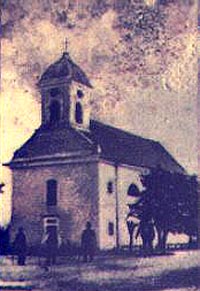|
Short History of the
Nitschkydorf Church
Translated by Duncan
Gardiner, 8 March 1990
© 1989
Duncan B. Gardiner,
Ph.D., C.G.
The building of a church
was the ardent wish of
the faithful. |
 |
|
In 1820 Pastor-Dean
Michael Fischl at the
age of 59, came to
Nitschkydorf. He was a
very energetic man and
we have him to thank
that already in 1824 the
long hoped-for church
was built. Holy Mass was
up to this point
celebrated in the
school, where there were
unfortunately only two
trees.
The construction was
begun by Anton Fleischer
of Sanktandreas. The
building foreman was
Paul Schlauch from New
Arad, (Palier?) was
Augustin Reiber, mason
Franz Kunst. Within 7
months the church was
finished. The
construction, of
entirely new building
material, was financed
by the administration.
The young people and
especially the children
of the village helped
greatly with the
building. The form of
the church can be seen
on the attached picture,
located after a long
search. The roof was
covered with shingles.
Before the dedication
the necessary
furnishings were ready;
Altar, tabernacle,
pulpit, communion
railing, and organ. Even
a bell was available.
The dedication was
performed on 7 Nov 1824
by Dean Anton Csajkay of
Rekasch because the
bishop, due to his
advanced age, could not
come. As the procession
arrived at the church,
the key was given, with
a short address to the
celebrants, to acting
building foreman
Augustin Bergmann. On a
small decorated table he
put, together with a
cross-decorated stone, a
capsule with the charter
which was blessed and
walled into the
foundation behind the
altar.
Pastor Dean Fischl held
the celebration speech.
The church, and the
town, were dedicated to
the Archangel Michael as
patron saint. The
townspeople felt great
happiness and jubilation
at finally, after 39
years, having a church
in the village. The
occasion is
traditionally
remembered, even today,
as the greatest village
holiday.
After the dedication the
first child was
baptized. Pastor Dean
Michael Fischl was the
godfather. The child was
christened Michael Wild.
The church is 30 meters
long, 13 meters wide
with arched ceilings.
The exterior of the
church was completed
only the next year, the
reason for the doorway
inscription of 1825.
Beneath it is the
inscription: Time Deum
et Honora Regem (Fear
God and honor the King).
In
the year 1911 the church
burned to its walls,
after which the roof was
renovated and the bell
tower was given the form
it has today, apparently
not so good looking as
it was supposed to have
been.
The roof, as today, was
covered with shingles.
The pastor's happiness
was short-lived; on 2
Sept 1827 his God
greeted him in heaven.
In
remembrance and thanks
to our ancestors we care
for the church and will
faithfully preserve what
they have created.
Extracted from the
village chronicle of our
townsman, Master Doctor
Fr(anz?) Krauter, whom
we keep in our thanks
and thoughts.
KONRAD MELLINGER and
Helper, GEORG GRASZL,
CHURCH ORGANIST, 20 SEPT
1987.
Photographs and Text by
Duncan Gardiner
© 1989
Duncan B. Gardiner,
Ph.D., C.G.;
Permission granted to
DVHH.org to republish.
Contact
Duncan B. Gardiner
| Also see:
German Settlements in
Eastern Europe
[Published at DVHH.org
05
Mar
2010 by Jody McKim Pharr]
|
Last
Updated:
18 May 2018 |
Keeping the Danube Swabian legacy alive
DVHH.org ©2003
Donauschwaben Villages Helping
Hands, a Nonprofit Corporation.
UP
|
|
| |
|